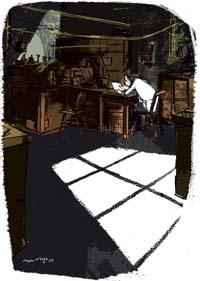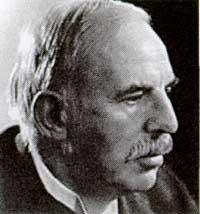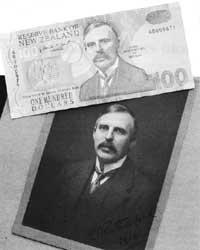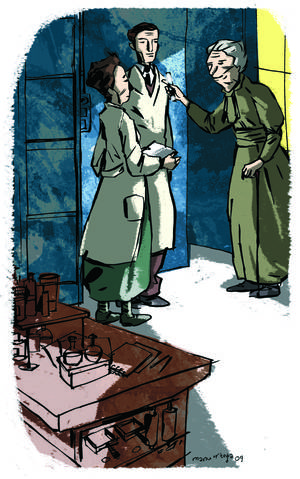Heritage of Rutherford
2010/01/01 Etxebeste Aduriz, Egoitz - Elhuyar Zientzia Iturria: Elhuyar aldizkaria

David Coggon's mission was to investigate whether those deaths were related to Rutherford. The study was launched in the case of three people who died with pancreatic cancer between 2007 and 2009. These three people worked at the University of Manchester, all three at Rutherford Building. And in previous years there were also three other similar deaths of people who worked in the same place.
Several people associated these deaths with experiments conducted by Rutherford himself a century earlier in that building. And to clarify the issue, the university commissioned Coggon, an epidemiologist at the UK Medical Research Council, to conduct a study.
Ernest Rutherford arrived at the University of Manchester in 1907, where he researched and taught until 1919. His lab was in what is now Rutherford Building. In this laboratory he worked with radioactive elements, where Rutherford discovered the structure of the atom thanks to radioactivity.
Rutherford was a great man, even physically. It was not particularly clear and, according to his friend James Chadwick, it was not particularly good in experimentation either. But it was tireless. Faced with seemingly insoluble problems, it was more determined than anyone else. And it was open to heterodox explanations. He also had a lot of self-confidence. C. P. Physicist Snow heard him once in the seamstress: "I am expanding every day physically, also mentally."
He liked simplicity; he used to say "I am a simple man." And the facts were the most important thing for Rutherford; the theory was only part of an "opinion". Thus, when Enrico Fermi managed to disintegrate certain elements with neutrons, he wrote to congratulate him on "escaping theoretical physics."
Born in New Zealand, he arrived in England in 1895, at the Cavendish laboratory of the University of Cambridge. The following year Henri Beckerel discovered radioactivity and Rutherford began to investigate this new phenomenon.
In 1898 he travelled to Canada to McGill University in Montreal. There, a year, working with uranium, he discovered that he emitted at least two types of radiation and named them with the first two letters of the Greek alphabet: alpha and beta rays. And, in 1903, together with Frederick Soddy, he concluded that radioactivity was due to the disintegration of the elements. It was a real revolution because at that time scientists considered matter indestructible. The Curie marriage also took two years to accept this idea, although they had shown that radioactive elements lost mass.
Soddy and Rutherford calculated the rate of disintegration of radioactive substances. And they saw that the energy released in these disintegrations could be between 20,000 and 100,000 times higher than other chemical reactions. Rutherford hypothesized that solar energy could have that origin. He also proposed that radioactive elements could be used for geological dating.
For these works she was awarded the Chemistry Novel in 1908. Yes, chemistry. For Rutherford, in addition, physics was well above all other sciences. When he was awarded the prize he said that the transformation of the physicist to the chemist was the fastest he ever knew.
By the time he was given the novel he was in Manchester and still had much to offer. The same year of the novel, together with Hans Geigger, he discovered that alpha particles were shining when playing in a zinc sulfide film. Thus, by observing these glitters, they could count the alpha particles one by one and follow their course.
The 19-year-old student Ernest Marsden was in charge of bombing a gold leaf with alpha particles and observing flashes. Most of the particles traversed gold directly, but only a few diverted and one in 20,000 bounced back. It was amazing! Rutherford would later say that it was equivalent to throwing and bouncing a cannonball to a cellophane role.
He finally found the explanation that most of the atom was an empty space, so most of the particles passed smoothly, but in the center of the atom there was a small nucleus that caused the deviation of some particles.
After counting thousands and thousands of flashes, they calculated that the nucleus of the atom was 10,000 times smaller than the atom itself, where almost the entire mass of the atom accumulated.
With the arrival of World War I, he was destined to investigate methods of detection of submarines, pioneers of sonar. One day he met with English experts to discuss these methods, Rutherford did not appear and when they went to take over he replied: "Quiet, please! Right now I mean some curious experiments that seem to be able to break the atom. If that were true, don't you think that discovery is more important than all your war?"
And he did it at the end of the war. In 1919 he realized that by bombarding nitrogen with alpha rays a proton was extracted from the nucleus of the nitrogen atom, thus becoming oxygen. It was the first artificial transmutation.
British physicist, mathematician and astronomer James Jeans once claimed that Rutherford was Newton of atomic physics. And the scientific legacy that Rutherford has left us is not at all. But did he leave any other heritage? Did Rutherford's work influence Manchester's deaths?
In 1999, radioactive contamination and mercury were detected in four Rutherford Building rooms and cleaned. However, Coggon has concluded that the dose received by an employee who received the maximum contamination before cleaning was 1.9 millisievert annually, a tenth of the dose established for nuclear power plant personnel. Coggon says he is sure that the deaths have been a mere coincidence.

Gai honi buruzko eduki gehiago
Elhuyarrek garatutako teknologia






